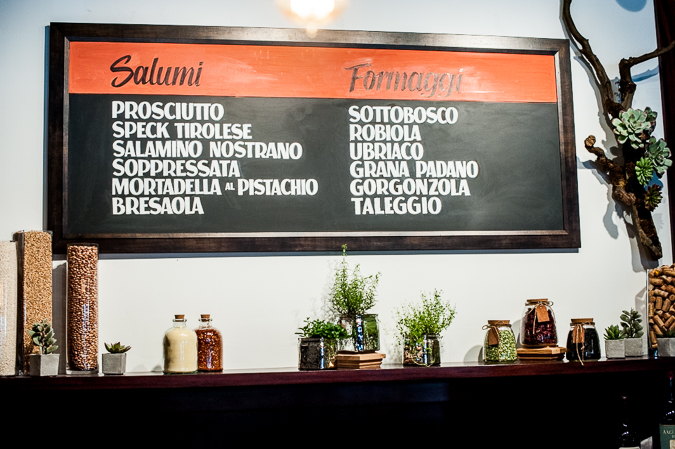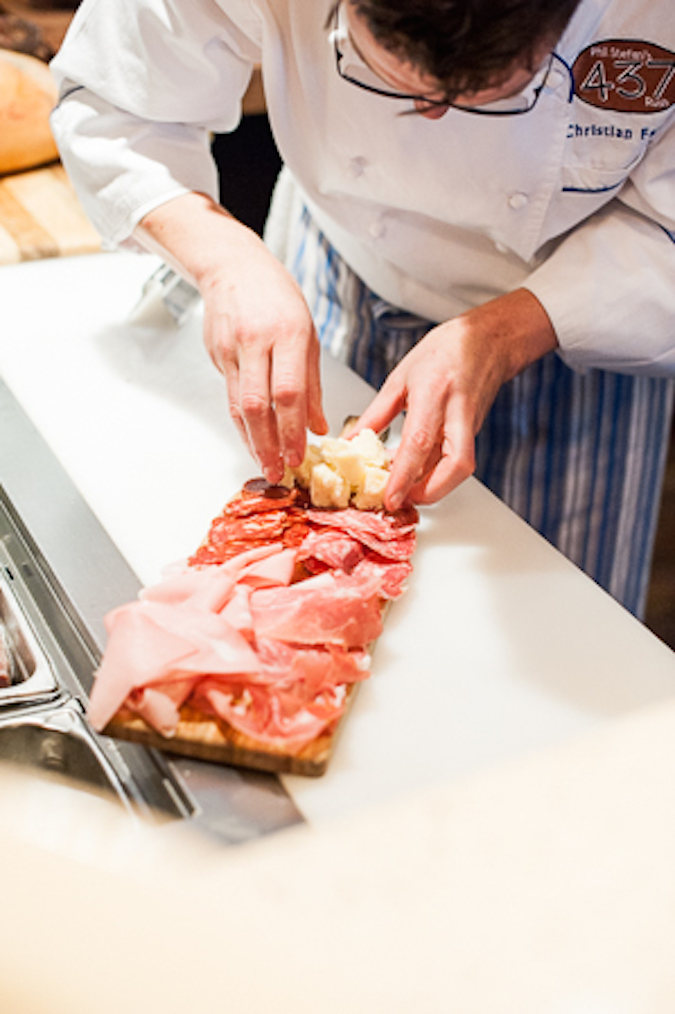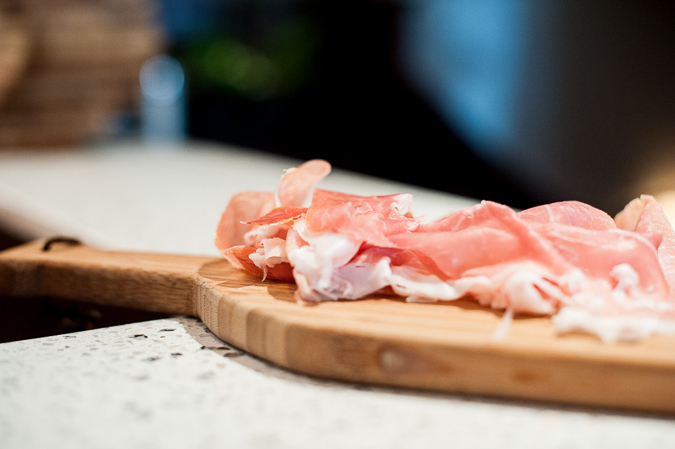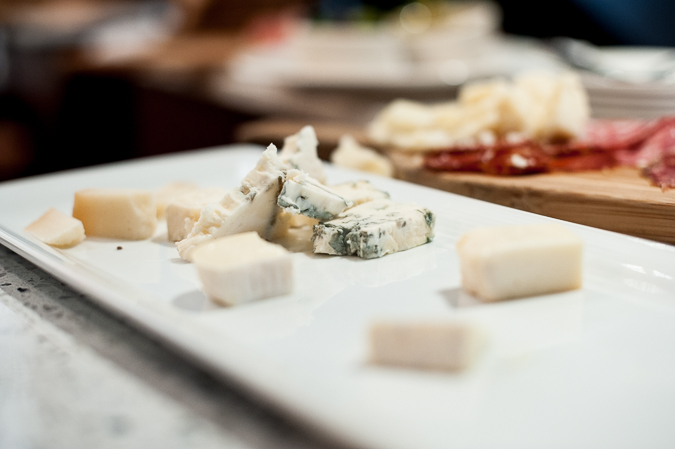It’s time to move beyond the cheese board, whether you’re planning your next dinner party or ordering from your favorite restaurant menu. A charcuterie and cheese board is the perfect way to feed a crowd.
Charcuterie, which is the branch of cooking devoted to prepared meat products, primarily pork products like bacon, ham, sausage, terrines, pâtés, and confit, are gaining popularity. Whether you want to add complementary cheeses, or bypass the cheese altogether, a charcuterie and cheese board is the perfect guest at any table.
Charcuterie and cheese boards are popping up on menus at eateries everywhere, ranging from the elegant to the easygoing. Because there are so many different ways to build the perfect board, price should not be a barrier that keeps you from getting your next cured meat fix.
If you’re trying to save more money by experimenting with boards at home, you can find most cured meats at your local, meat market, butcher shop or specialty grocery store. At your next dinner party or date night, give guests their choice of the best local charcuterie, in a mix of flavors and textures…and save the cooking for later.
I recently spent an afternoon with Chef Christian Fantoni at his renown salumeria bar at Phil Stefani’s 437 Rush in Chicago, who taught us everything we need to know about making a charcuterie board to rival even the best Italian chef’s.
Though it’s easy enough to assemble a killer charcuterie board at home, Fantoni has a leg up in the salumeria game with an original handmade and hand-painted 1934 Van Berkel slicer.
Berkel is the first slicing machine to be produced by the inventor Van Berkel and known to be the only slicer in the world operated by hand rather than electric, which keeps the blade cold when slicing the meat, and therefore does not heat or ‘cook’ the meat when it hits the blade.
The slicer at 437 Rush was handmade in Italy, with pieces of metal sent over from Netherland, the original factory it was born in.
“The machine cuts meat so thin that if you held it up taught over a newspaper, you would be able to read through it,” said Fantoni. “When you eat sliced prosciutto, it should be so thin that you can read through it. If you can’t see through it, then the slices are too thick.”
Even if you don’t have a “Ferrari of meat slicers,” as Fantoni calls his appliance, in your home kitchen, you’ll be able to whip up an impressive selection.
I chatted with Fantoni about the types of meat and cheese you can find on the market — and how to mix and match them to suit your tastes.
Charcuterie Boards
Charcuterie boards don’t need to be a one size fits all experience.
Whether your meat selection is on the menu at a restaurant or in the deli case of a grocer or butcher’s counter, knowledge is power.
Think about what flavor profiles you want to experience and don’t be afraid to ask your butcher or server for recommendations.
“A good chef likes to educate people and help shape palates,” said Fantoni.
Bresaola
Bresaola is air-dried, salt-cured beef that has been aged two or three months until it becomes hard and turns a dark red, almost purple color. It’s best served sliced very, very thin and paired with simple accompaniments like extra-virgin olive oil, lemon, arugula and shaved parmesan.
Prosciutto
At Phil Stefani’s, Fantoni dishes up prosciutto, that has been aged for 24 months. The dry-cured ham is served uncooked (although since it’s been cured for so long, it isn’t exactly raw) and sliced very, very thin — thin enough that you could read a newspaper right through it.
Prosciutto is traditionally made from the hind leg of a pig and while frequently confused with pancetta or even bacon, is distinguished by its dry-aging process and thin, salty texture.
Speck
Although “speck” is an English word that basically means “fat” or “blubber,” when you see it on a charcuterie menu it has a very different meaning. Speck is a thinly sliced ham product, very similar to prosciutto.
Unlike prosciutto, which is sliced fresh from the bone, speck has been deboned, flattened and spiced with black pepper, juniper and thyme. Speck is usually dry-cured and smoked and served as is.
Mortadella
According to Fantoni, most Americans are actually familiar with the classical Italian “mortadella” ham. Known throughout the U.S. as bologna sausage, or baloney, Mortadella is a cured meat that has been imported from Parma after aging for six months.
Mortadella is made from finely hashed or ground, heat-cured pork sausage, which incorporates at least 15% small cubes of pork fat (principally the hard fat from the neck of the pig). Dotted with pistachios, Mortadella has a nuttiness and is an Italian staple on any charcuterie serving.
Sopressata
Sopressata is an italian dry salami, made from fresh pork or beef. The meat is either coarsely pressed or ground and at Phil Stefani’s, Fantoni uses the owner’s traditional Tuscan recipe that includes a touch of chili pepper and chili flakes.
Sopressata is pressed under marble slabs and over time, presses together. It is commonly sliced thin and placed on crackers or sandwiches or eaten by itself, but is also becoming a popular alternative to pepperoni for pizza toppings at U.S. pizzerias.
Salamino Nostrano
A cousin to Sopressata, Salamino Nostrano is a salted, flavored and seasoned pork product. Flavored with white wine and peppercorns, Salamino Nostrano pairs perfectly with fruit, melon or figs.
Cheese Boards
When you have a beautiful array of charcuterie in place, the next step is adding the perfect cheeses to complement your board.
“Gourmet supermarkets have a good selection of Italian cheeses,” said Fantoni. “Ask your grocery store if they have a cheese master or a cheese monger who can help you select options to please your palate.”
Tell them your favorite characteristics in a cheese, be it tangy or creamy. Most cheese counters will let you sample the cheese to make sure it suits your preferences.
When you’re pairing cheese with your charcuterie, any hard and salty cheese is 90% likely to pair well with meat. “One of the greatest pairings is truffle cheese and prosciutto,” said Fantoni. “You also can’t go wrong with any combination of creamy and salty.”
Ubriaco
Affectionately called “drunken cheese” we love this cow’s milk cheese that has been macerated in a wine press in the juice from crushed grapes. Matured for a minimum of 2 months but rarely for over a year, Umbriaco has a flowery aroma, a soft supple texture and is best served in crumbles or shavings.
Sotto Bosco
Made from a perfect blend of cow and goat’s milk with black truffle, Sotto Bosco literally translates to “under the forest.” Laced with black truffles, the rustic cheese has a creamy mouthfeel, nutty and savory notes and a garlicky finish. Serve with a glass of bold red wine or Prosecco.
Robiola
Made from a combination of cow, goat and sheep’s milk all in one, Robiola is a triple-crème cheese. “Triple-crème means that a cheese was made with three different types of milk,” said Fantoni. “It can be a combination of cow’s milk, which is the mildest; sheep’s milk, which adds sweetness and goat’s milk, which adds tanginess and pungency.”
Serve Robiola with olive oil, salt and pepper or add it to a risotto or pasta dish.
Gorgonzola
Many are stymied by the difference between gorgonzola and traditional blue cheese, but the results are in: Gogonzola is an Italian blue cheese made from cow and sheep’s milk, with added penicillin. Three months into the aging process, metal rods are quickly inserted and removed, creating air channels that allow the ‘good bacteria’ to grow and create the characteristic veining of blue cheeses.
Serve Italian blue cheese raw or in pasta, risotto or pizza.
Taleggio Cheese
A semi-soft, washed rind Italian cheese, Taleggio is known for its thin crust and a strong aroma. ” It’s one of the stinkiest cheeses you can imagine,” said Fantoni. “As bad as it smells, it is one of the most flavorful of all cheeses. Aged for more than eight months, it’s very, very pungent.”
Normally served without its thin crust, Taleggio is perfect grated on salads or bruschetta and melts well in bruschetta or polenta.
Pairings and Accompaniments
If you’re stocking up to serve charcuterie and cheese at home, there are a few things you must not forget. First, pick up a few olives or peppers to complement the rich and salty flavors of your cheese.
Fantoni likes a combination of Castelvetrano, and Ligurian and Black Cerignola olives, along with a few Lombardi peppers that are tangy and sweet, but not super spicy. “They’re a nice palate cleanser in between bites,” said Fantoni.
When it comes to wine pairings, Fantoni said that some people prefer pairing charcuterie with a bold, red Barolo or Barbera that will stand up to the meats. Others opt for a light Sauvignon Blanc that will cut the richness of the meal with its light and dry flavor profile.


























8 Comments
18 Cheese Boards That You Probably Need Right Now - In Good Taste
December 10, 2018 at 10:45 pm[…] hope that you or someone on your list need a cheese board for your next cheese and charcuterie board or wine and cheese […]
Host a BYOB Wine and Cheese Party - In Good Taste
September 8, 2017 at 9:26 pm[…] cured meats into a classic charcuterie display. My favorite way to serve charcuterie is to make a charcuterie plate like an Italian chef, selecting a nice variety of cheeses and meats for […]
Warm Brie with Wild Mushrooms - In Good Taste
October 2, 2016 at 8:33 pm[…] would be better saved for the main event? We love the idea of serving a simple cheese platter or an Italian charcuterie and cheese board, but if you want to keep it simple, a wheel of warm brie with wild mushrooms is a crowd […]
How-To: Host a Winter Brunch (and sleep in) - In Good Taste
December 30, 2015 at 4:29 pm[…] I firmly believe that a party isn’t a party if you don’t have a proper cheese plate. We have covered cheese plates a lot here: how to make the perfect cheese plate and of course, one of our most popular posts: how to make an Italian cheese and charcuterie board. […]
Easy Rigatoni with Spicy Tomato Cream Sauce - In Good Taste
December 7, 2015 at 11:31 am[…] Italian Charcuterie Board […]
The 10 Best Rosé Wines You Can Still Drink This Summer - In Good Taste
September 2, 2015 at 10:28 pm[…] Pick: 2014 Cocomero Rosato (Club W) Pairing: Cheese and Charcuterie Why: Cocomero is our homage to Tuscany and the Italian love of watermelon, and it’s extra […]
What is a Salumeria? » Phil Stefani Signature Restaurants
June 25, 2014 at 8:46 pm[…] That’s impressive and all, but what kind of meat are we slicing on this Berkel?! This is where we turn it over to our friends at In Good Taste Magazine. Editor Maris Callahan spent an afternoon with Chef Christian Fantoni at our renown salumeria bar and he taught her everything one needs to know about making a charcuterie board to rival even the best Italian chef’s. She details the characteristics of each meat and cheese beautifully! Read the delicious details here. […]
New Look at 437 Rush » Phil Stefani Signature Restaurants
June 25, 2014 at 8:02 pm[…] exciting new addition to the space is a Salumeria Bar, complete with an original handmade and hand-painted 1934 Van Berkel slicer. This slicing machine […]